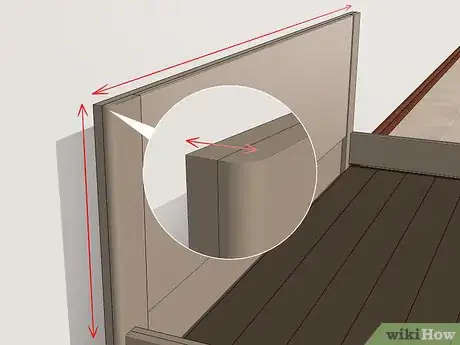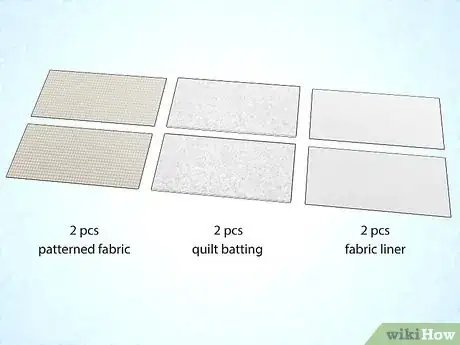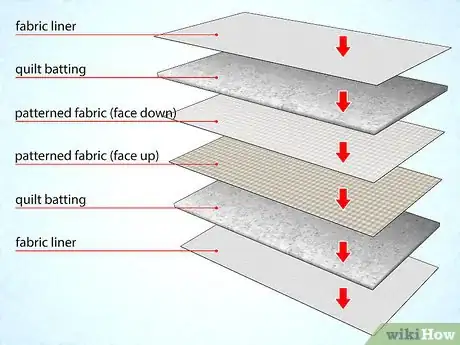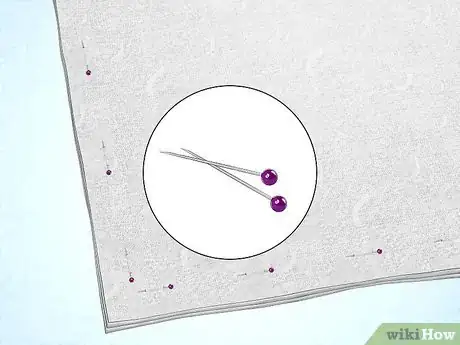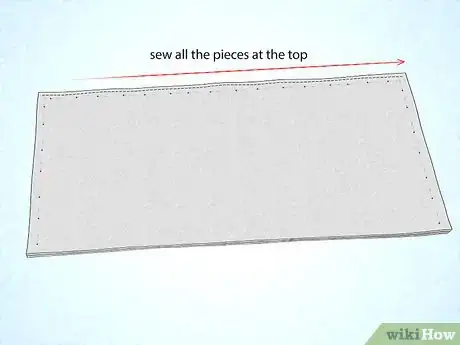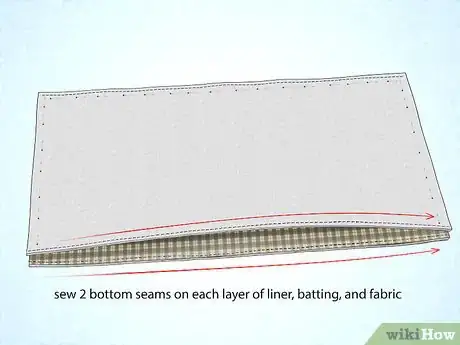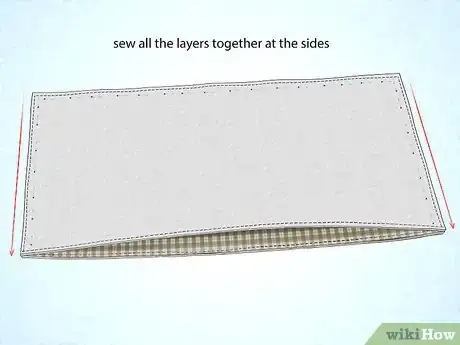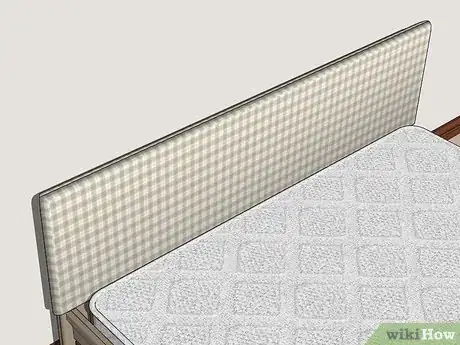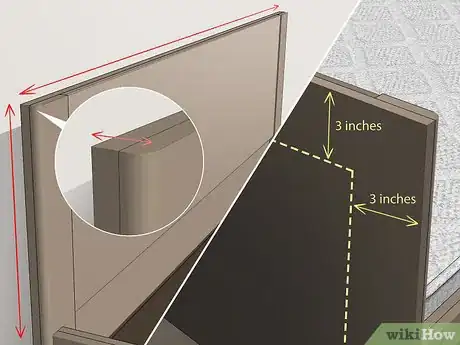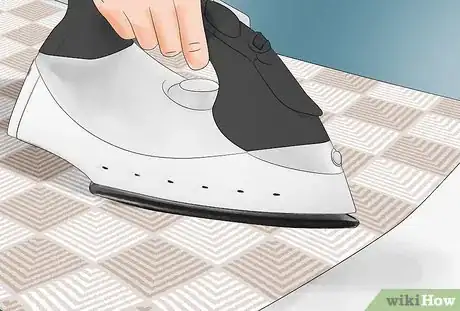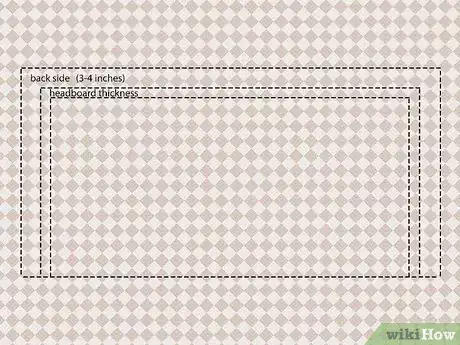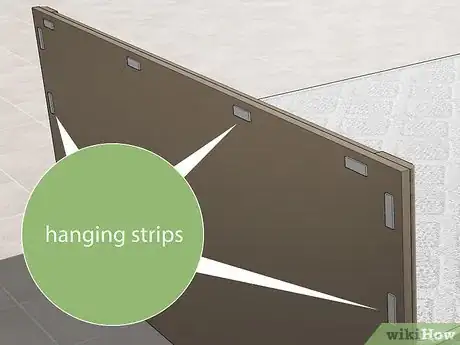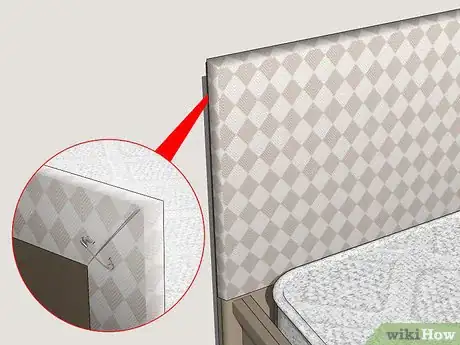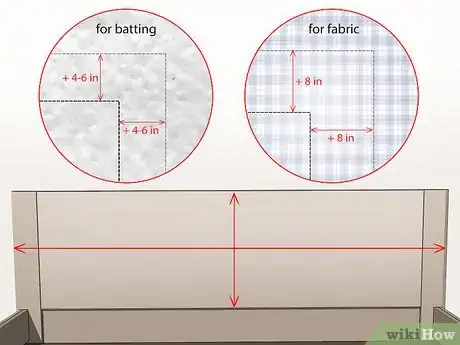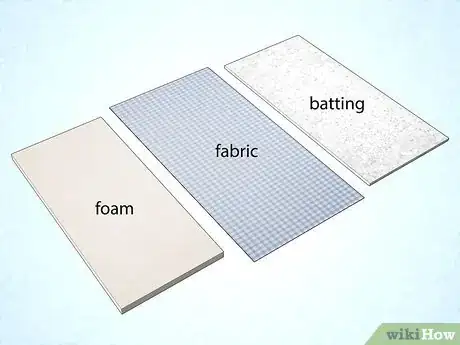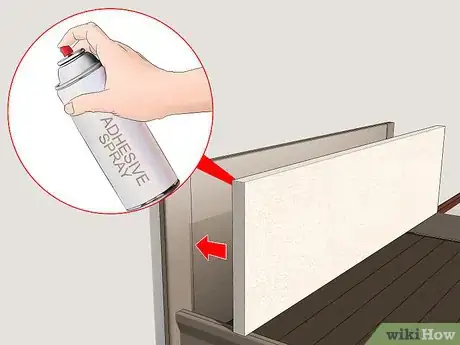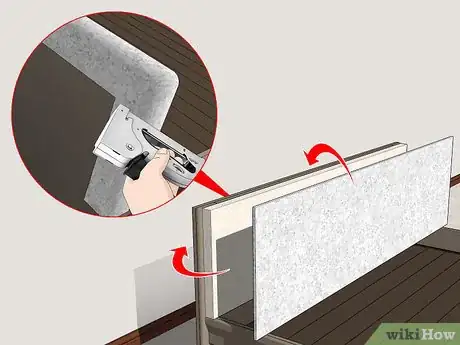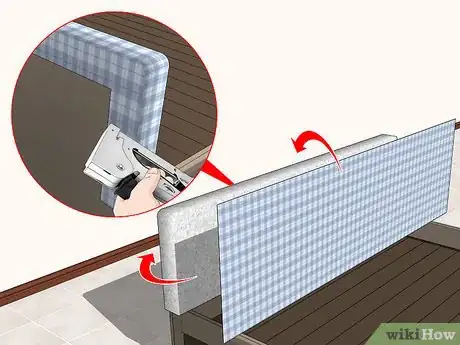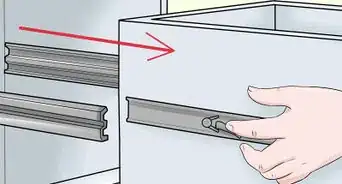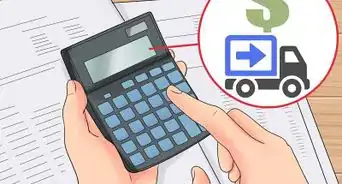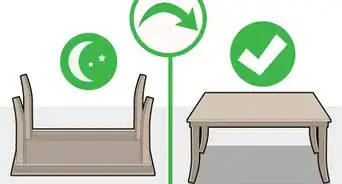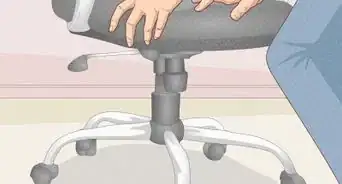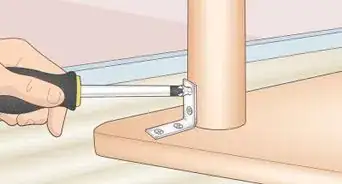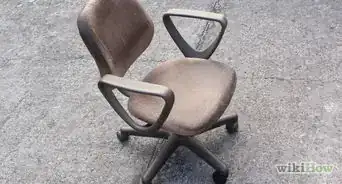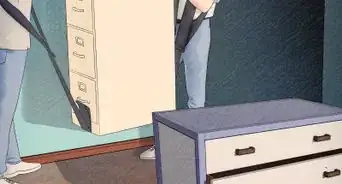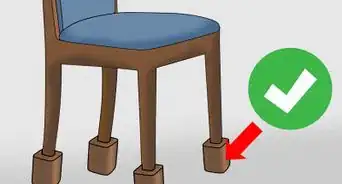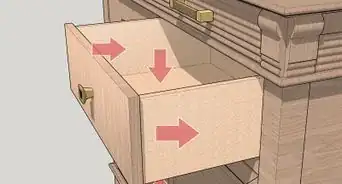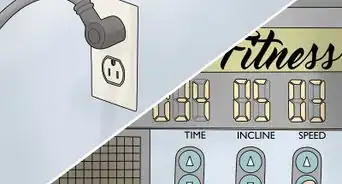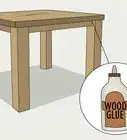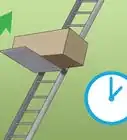This article was co-authored by Garrison Hullinger. Garrison Hullinger is an Interior Designer and the President of Garrison Hullinger Interior Design (GHID). With more than 15 years of experience, he specializes in client-centered design that balances beauty and warmth with comfort and functionality. Garrison and GHID’s work has been featured in numerous publications such as The New York Times, The Wall Street Journal, and Interior Design Magazine. Garrison attended Oklahoma Christian University.
This article has been viewed 37,934 times.
When you’re tired of how your headboard looks, or you want to give it a soft cover for added comfort, you have a couple of DIY options to get the job done. Make a removable slip cover to cover any kind of headboard, or permanently upholster a wooden headboard to completely refurbish it. With some fabric, padding, and a few other supplies, you’ll be able to finish this DIY project in just a few hours and have a headboard that looks brand new!
Things You Should Know
- You can sew a simple padded slipcover for your headboard using patterned fabric, quilt batting, and fabric liner.
- For an easier option, you can make a no-sew headboard cover by cutting a single sheet of fabric and attaching it to the headboard with Velcro strips.
- To permanently cover the headboard, use adhesive spray to adhere batting, fabric, and foam directly.
Steps
Sewing a Padded Slipcover for Any Headboard
-
1Measure the headboard to determine how much fabric you need. Measure the length and width of the headboard with a tape measure. Measure the thickness of the headboard and add this number to each measurement.[1]
- For example, if the headboard is 36 in (91 cm) wide by 24 in (61 cm) tall, and 3 in (7.6 cm) thick, then you need 2 pieces of 39 in (99 cm) by 27 in (69 cm) fabric to sew the cover.
- You can chose 2 different patterns of fabric for the front and back of the slipcover to make it reversible.[2]
-
2Cut 2 pieces each of patterned fabric, quilt batting, and liner to the right size. Mark your chosen patterned fabric, fabric liner, and 1 in (2.5 cm) thick stiff quilt batting with a pen to match the measurements you got from measuring the headboard. Use fabric scissors to cut them to size.[3]
- You can use an old sheet or any spare fabric to make the liner, since you will not see this part.
- Make sure that you use the stiffest quilt batting you can find to give the slipcover its structure.
Advertisement -
3Layer the liner, batting, and patterned fabric in the order you will sew them. Lay down a piece of liner first, then a piece of batting, then a piece of patterned fabric face up. Lay the next piece of patterned fabric face down, then a piece of batting, and finally the last piece of liner.[4]
- You will sew the slipcover inside out to hide the seams, and then flip it so the liners are on the inside and the patterned fabric pieces face outwards.
-
4Pin all the pieces together with sewing pins. Place pins with the sharp points facing inwards towards the center of the fabric cover and the round heads facing outwards. Put a pin approximately every 6 in (15 cm) to secure all the layers together.[5]
- You will remove the pins as you sew, so don’t put them too close together or it will be a very slow process.
-
5Sew all the pieces at the top together with a straight stitch to create the top seam.[6] Run all 6 pieces together through a sewing machine to create the top seam. Remove the pins holding the layers together as you work so you don’t hit them with the needle.[7]
- It’s possible to sew over the pins holding the layers together and remove them after, but if the sewing machine’s needle hits a pin, it could break.
- You can use a 1⁄4 in (0.64 cm) seam allowance on the sewing machine when you sew all the seams.
-
6Sew 2 bottom seams on each layer of liner, batting, and fabric at the bottom. Use your sewing machine to sew the first 3 pieces together to create the first bottom seam. Sew the next 3 pieces together to create the second bottom seam.[8]
- Sewing 2 bottom seams will leave the slit that will allow the slipcover to slide onto the headboard. You may want to fold up the bottom edges and sew a hem to hide the raw fabric edges.
-
7Sew all the layers together at the sides to make the side seams. Sew 1 side first, and then see how it fits over the headboard. Re-pin the layers of the last side so that it fits tight, then sew it together.[9]
- You may also want to trim away excess material before you sew the last seam.
-
8Flip the slipcover inside out and put it on the headboard. Turn the completed cover inside out out so the seams are on the inside and the patterned fabric faces outward. Slide it on over the headboard and you are done.[10]
Making a No-Sew Headboard Cover
-
1Get a piece of fabric that you want to use to cover the headboard.[11] Measure the height, width, and thickness of the headboard to determine how big you need the piece to be. Add the thickness to both the width and height, plus an extra 3 in (7.6 cm) or so to allow it to wrap around the backside.[12]
- You can use any large piece of fabric you want, such as a curtain or sheet. It may be helpful to use fabric that has sewn hems to prevent any fraying in the future.
- For example, if the headboard is 36 in (91 cm) wide by 24 in (61 cm) tall, and 3 in (7.6 cm) thick, then you would want a piece of fabric about 42 in (110 cm) by 30 in (76 cm) so that it can wrap around the backside comfortably.
-
2Iron the fabric to make it wrinkle-free. Lay your chosen fabric out on an ironing board or flat surface that is safe to iron on. Iron it until you don’t see any wrinkles or creases.
- Steam irons work great for this part.[13]
-
3Cut the fabric with fabric scissors to fit the headboard. Measure the width of the headboard and then add about 4 in (10 cm) to that on each side so that the fabric will wrap around the back. Do the same for the height of the headboard.[14]
- You can always trim off extra fabric later, so it’s ok to add a bit more to the height and width than you actually need.
-
4Stick picture hanging strips to the back of the headboard and stick the fabric on. Use at least 3 double-sided sticky picture hanging strips. Put 1 on the back of each of the posts and 1 on the back of the top part in the middle, then wrap the fabric around the headboard and stick it to the strips..[15]
- You can use as many adhesive strips as you want for added stability.
- Sew the sticky strips to the fabric if they are not adhesive enough to stick to the fabric on their own.
-
5Use safety pins to pin excess fabric in the back for a tighter fit. Pin the fabric in the back corners or anywhere else where it looks a little loose. Fold the excess fabric like a present and then secure it in place with safety pins.[16]
- This is especially useful if you have an odd-shaped headboard that is rounded at the top.
Upholstering a Wooden Headboard
-
1Measure your headboard to see how much foam, batting, and fabric you need. Use a measuring tape to measure the length and width of the headboard you want to upholster. Add 4–6 in (10–15 cm) to the length and width the get the size of batting you need, add 8 in (20 cm) to the length and width to determine the size of fabric you need, and keep the measurements the same for the foam.[17]
- For instance, if the headboard is 36 in (91 cm) wide by 24 in (61 cm) tall, then your upholstery foam piece will be exactly the same size, the batting you use should be at least 40 in (100 cm) wide by 28 in (71 cm) tall, and the fabric piece should be 44 in (110 cm) wide by 32 in (81 cm) tall.
- You can also make your own upholstered headboard from plywood.[18]
-
2Cut the foam, batting, and fabric to the measurements you got. Mark the measurements you came up with on a piece of upholstery foam, a piece of upholstery batting, and a piece of fabric with a fabric marker or chalk. Use fabric scissors for the fabric, and a utility knife or scissors to cut the foam and batting to size.[19]
- Make sure that if you use a utility knife, you cut the foam on top of something that you won’t damage, like a scrap piece of wood.
-
3Spray 1 side of the foam with adhesive and stick it to the headboard. Hold a can of spray adhesive about 6 in (15 cm) from the foam and press the nozzle down to spray it on. Cover the whole side of the foam evenly, and then press it against the headboard carefully to stick it on.[20]
- It’s a good idea to lay something under the foam like an old sheet or a piece of plastic to avoid getting spray adhesive where it shouldn’t be.
- If you are working inside, then open windows and doors to ventilate the room as much as possible.
-
4Center the batting on the headboard and staple the extra to the back side. Place the upholstery batting flat on the floor and place the headboard in the middle so that it has an even amount of extra batting on all sides of the headboard. Fold the extra batting to the back, then use a staple gun to put a staple every couple of inches to hold it in place.[21]
- Make sure to pull the batting as taught as you can while you staple it.
-
5Center the fabric over the batting and staple the extra to the back. Lay the fabric face down on the ground and smooth it out as much as possible, then put the headboard face down in the middle. Start at the center of the top of the headboard and pull the extra fabric as taught as you can. Work your way around the whole headboard, putting a staple every couple of inches.[22]
- When you get to the corners of the fabric, pretend you are wrapping a present to fold the fabric neatly before you staple it.
- Trim away any excess fabric with fabric scissors when you are done stapling it to the back of the headboard.
Expert Q&A
-
QuestionWhat can I use to cover my headboard?
 Garrison HullingerGarrison Hullinger is an Interior Designer and the President of Garrison Hullinger Interior Design (GHID). With more than 15 years of experience, he specializes in client-centered design that balances beauty and warmth with comfort and functionality. Garrison and GHID’s work has been featured in numerous publications such as The New York Times, The Wall Street Journal, and Interior Design Magazine. Garrison attended Oklahoma Christian University.
Garrison HullingerGarrison Hullinger is an Interior Designer and the President of Garrison Hullinger Interior Design (GHID). With more than 15 years of experience, he specializes in client-centered design that balances beauty and warmth with comfort and functionality. Garrison and GHID’s work has been featured in numerous publications such as The New York Times, The Wall Street Journal, and Interior Design Magazine. Garrison attended Oklahoma Christian University.
Interior Designer One really cool option is to take a sheepskin or Sherpa fabric and drape it across the entire top of the headboard. Just let it be a layering piece that creates this boho textural moment over your headboard.
One really cool option is to take a sheepskin or Sherpa fabric and drape it across the entire top of the headboard. Just let it be a layering piece that creates this boho textural moment over your headboard. -
QuestionIs it easy to cover a headboard?
 Garrison HullingerGarrison Hullinger is an Interior Designer and the President of Garrison Hullinger Interior Design (GHID). With more than 15 years of experience, he specializes in client-centered design that balances beauty and warmth with comfort and functionality. Garrison and GHID’s work has been featured in numerous publications such as The New York Times, The Wall Street Journal, and Interior Design Magazine. Garrison attended Oklahoma Christian University.
Garrison HullingerGarrison Hullinger is an Interior Designer and the President of Garrison Hullinger Interior Design (GHID). With more than 15 years of experience, he specializes in client-centered design that balances beauty and warmth with comfort and functionality. Garrison and GHID’s work has been featured in numerous publications such as The New York Times, The Wall Street Journal, and Interior Design Magazine. Garrison attended Oklahoma Christian University.
Interior Designer Yes, it is! You can easily make a slipcover with your favorite fabrics, and that doesn't really take a lot of sewing.
Yes, it is! You can easily make a slipcover with your favorite fabrics, and that doesn't really take a lot of sewing.
Things You’ll Need
Sewing a Padded Slipcover for a Headboard
- Fabric
- Thread
- Sewing machine
- 1 in (2.5 cm) thick stiff quilt batting
- Measuring tape
- Fabric scissors
- Sewing pins
- Pen
Making a No-Sew Headboard Cover
- Fabric
- Picture hanging adhesive strips
- Fabric scissors
- Safety pins
- Iron
Making an Upholstered Headboard
- 1 in (2.5 cm) thick upholstery foam
- 1 in (2.5 cm) thick upholstery batting
- Fabric
- Spray adhesive
- Staple gun
- Fabric scissors
- Measuring tape
References
- ↑ https://inmyownstyle.com/easy-sew-reversible-padded-headboard-cover.html
- ↑ Garrison Hullinger. Interior Designer. Expert Interview. 11 November 2021.
- ↑ https://inmyownstyle.com/easy-sew-reversible-padded-headboard-cover.html
- ↑ https://inmyownstyle.com/easy-sew-reversible-padded-headboard-cover.html
- ↑ https://inmyownstyle.com/easy-sew-reversible-padded-headboard-cover.html
- ↑ Garrison Hullinger. Interior Designer. Expert Interview. 11 November 2021.
- ↑ https://inmyownstyle.com/easy-sew-reversible-padded-headboard-cover.html
- ↑ https://inmyownstyle.com/easy-sew-reversible-padded-headboard-cover.html
- ↑ https://inmyownstyle.com/easy-sew-reversible-padded-headboard-cover.html
- ↑ https://inmyownstyle.com/easy-sew-reversible-padded-headboard-cover.html
- ↑ Garrison Hullinger. Interior Designer. Expert Interview. 11 November 2021.
- ↑ https://www.remodelaholic.com/easy-no-sew-headboard-slipcover-tutorial/
- ↑ https://www.remodelaholic.com/easy-no-sew-headboard-slipcover-tutorial/
- ↑ https://www.remodelaholic.com/easy-no-sew-headboard-slipcover-tutorial/
- ↑ https://www.remodelaholic.com/easy-no-sew-headboard-slipcover-tutorial/
- ↑ https://www.remodelaholic.com/easy-no-sew-headboard-slipcover-tutorial/
- ↑ https://www.housebeautiful.com/uk/renovate/upcycle/news/a365/how-to-make-a-fabric-covered-headboard/
- ↑ https://www.thisoldhouse.com/how-to/how-to-make-upholstered-headboard
- ↑ https://www.housebeautiful.com/uk/renovate/upcycle/news/a365/how-to-make-a-fabric-covered-headboard/
- ↑ https://www.housebeautiful.com/uk/renovate/upcycle/news/a365/how-to-make-a-fabric-covered-headboard/
- ↑ https://www.housebeautiful.com/uk/renovate/upcycle/news/a365/how-to-make-a-fabric-covered-headboard/
- ↑ https://www.housebeautiful.com/uk/renovate/upcycle/news/a365/how-to-make-a-fabric-covered-headboard/
